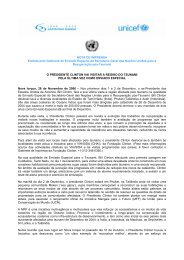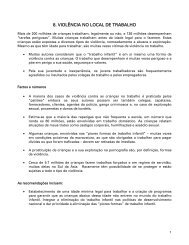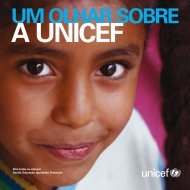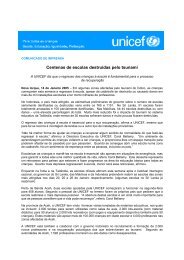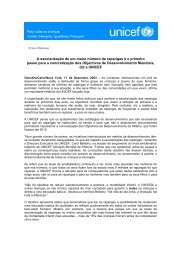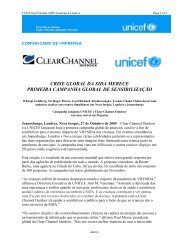Tracking Progress on Child and Maternal Nutrition - Unicef
Tracking Progress on Child and Maternal Nutrition - Unicef
Tracking Progress on Child and Maternal Nutrition - Unicef
You also want an ePaper? Increase the reach of your titles
YUMPU automatically turns print PDFs into web optimized ePapers that Google loves.
Community-based management of<br />
severe acute malnutriti<strong>on</strong> in Malawi<br />
In Malawi each year, there are an estimated 59,000 children<br />
with severe acute malnutriti<strong>on</strong>. Around 59 per cent of<br />
these children are currently being treated, at a recovery<br />
rate of more than 75 per cent, which makes Malawi a<br />
leader globally in achieving results in the management of<br />
severe acute malnutriti<strong>on</strong>. A vital comp<strong>on</strong>ent of Malawi’s<br />
success has been the introducti<strong>on</strong> of community-based<br />
management of the c<strong>on</strong>diti<strong>on</strong>.<br />
Poor nutriti<strong>on</strong>al status has been a chr<strong>on</strong>ic problem in<br />
Malawi. In additi<strong>on</strong> to endemic diseases <strong>and</strong> the AIDS<br />
epidemic, from 2001–2006 Malawi experienced persistent<br />
episodes of food shortage <strong>and</strong> other humanitarian crises.<br />
The rate of global acute malnutriti<strong>on</strong> nati<strong>on</strong>ally was<br />
6.2 per cent in 2005; four districts had rates above<br />
10 per cent. Prior to 2006, management of severe acute<br />
malnutriti<strong>on</strong> took place <strong>on</strong> an inpatient basis in paediatric<br />
wards <strong>and</strong> in nutriti<strong>on</strong> rehabilitati<strong>on</strong> units using the<br />
milk-based therapeutic preparati<strong>on</strong>s.<br />
In 2002, however, the n<strong>on</strong>-governmental organizati<strong>on</strong>s<br />
C<strong>on</strong>cern Worldwide <strong>and</strong> Valid Internati<strong>on</strong>al introduced an<br />
innovative approach using ready-to-use therapeutic food<br />
to increase coverage of treatment for severe acute<br />
malnutriti<strong>on</strong>. The initiative, anchored at the district level,<br />
encourages communities to identify severely undernourished<br />
children before they require inpatient care. Effective<br />
treatment is then given <strong>on</strong> a weekly basis at local health<br />
structures or at distributi<strong>on</strong> sites within a day’s walk of<br />
people’s homes. Inpatient care is available for complicated<br />
cases.<br />
These efforts led to exp<strong>and</strong>ed coverage of effective<br />
treatment, reaching 74 per cent of those in need,<br />
compared to 25 per cent for the traditi<strong>on</strong>al approach.<br />
After extending the initiative to additi<strong>on</strong>al districts<br />
following a 2004 review, the model was adopted as a<br />
nati<strong>on</strong>al strategy in 2006, <strong>and</strong> its gradual scale-up <strong>and</strong><br />
integrati<strong>on</strong> into the primary-health-care system began. By<br />
March 2009, the programme had been scaled up to 330<br />
outpatient <strong>and</strong> 96 inpatient sites in all of the country’s 27<br />
districts, <strong>and</strong> it is expected to eventually reach all health<br />
facilities in the country.<br />
Sources: Community-based Management of Severe Acute Malnutriti<strong>on</strong>: A joint<br />
statement by the World Health Organizati<strong>on</strong>, the World Food Programme, the<br />
United Nati<strong>on</strong>s System St<strong>and</strong>ing Committee <strong>on</strong> Nutriti<strong>on</strong>, <strong>and</strong> the United Nati<strong>on</strong>s<br />
<strong>Child</strong>ren’s Fund, WHO, WFP, SCN <strong>and</strong> UNICEF, Geneva, Rome <strong>and</strong> New York,<br />
May 2007; <strong>and</strong> UNICEF Malawi Country Offi ce Annual Reports <strong>and</strong> other<br />
internal documents.<br />
32 <str<strong>on</strong>g>Tracking</str<strong>on</strong>g> <str<strong>on</strong>g>Progress</str<strong>on</strong>g> <strong>on</strong> <strong>Child</strong> <strong>and</strong> <strong>Maternal</strong> Nutriti<strong>on</strong><br />
In many countries <strong>and</strong> communities, households face<br />
periods of seas<strong>on</strong>al food shortage, or adequate nutritious<br />
food may be unavailable to families <strong>on</strong> a c<strong>on</strong>tinual basis.<br />
This situati<strong>on</strong> needs to be addressed in order to ensure<br />
adequate maternal nutriti<strong>on</strong> <strong>and</strong> complementary feeding<br />
for infants <strong>and</strong> young children, as well as to sustain reducti<strong>on</strong>s<br />
in undernutriti<strong>on</strong> over the l<strong>on</strong>g term. Interventi<strong>on</strong>s<br />
include measures to improve agricultural producti<strong>on</strong> <strong>and</strong> to<br />
increase food availability through social protecti<strong>on</strong> schemes<br />
<strong>and</strong> food distributi<strong>on</strong> programmes.<br />
The table <strong>on</strong> the following pages offers detailed informati<strong>on</strong><br />
<strong>on</strong> the priority interventi<strong>on</strong>s for the preventi<strong>on</strong> of undernutriti<strong>on</strong><br />
<strong>and</strong> the treatment of severe <strong>and</strong> moderate acute<br />
malnutriti<strong>on</strong> to be delivered at stages of the life cycle<br />
between the woman’s pregnancy <strong>and</strong> the child’s sec<strong>on</strong>d<br />
birthday. Some of these preventive acti<strong>on</strong>s should begin<br />
in adolescence, before the woman becomes pregnant, <strong>and</strong><br />
c<strong>on</strong>tinue after the child reaches 24 m<strong>on</strong>ths of age. Many of<br />
these interventi<strong>on</strong>s endeavour to change behaviour <strong>and</strong> will<br />
depend <strong>on</strong> the successful implementati<strong>on</strong> of large-scale<br />
communicati<strong>on</strong> strategies.<br />
Adequate nutriti<strong>on</strong> is also of key importance for children<br />
more than 2 years old, <strong>and</strong> interventi<strong>on</strong>s such as vitamin A<br />
supplementati<strong>on</strong>, zinc treatment for diarrhoea, management<br />
of acute malnutriti<strong>on</strong>, <strong>and</strong> communicati<strong>on</strong> <strong>and</strong> counselling<br />
<strong>on</strong> the preventi<strong>on</strong> of both undernutriti<strong>on</strong> <strong>and</strong> overweight<br />
are also crucial for these children.



